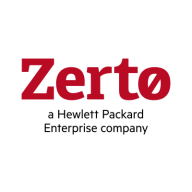


Zerto and Avepoint FLY are competing in the data management and migration category, each offering distinct advantages. Zerto may have the edge in disaster recovery, while Avepoint FLY has stronger cloud migration capabilities.
Features: Zerto is recognized for disaster recovery, backup features, and integration with virtualized environments, essential for businesses prioritizing continuity. Avepoint FLY is strong in specialized migration tools, offering compatibility with multiple cloud platforms, ideal for efficient data migrations.
Ease of Deployment and Customer Service: Zerto focuses on streamlined deployment with solid virtualization support and responsive customer service. Avepoint FLY emphasizes user-friendly deployment catering to diverse technical expertise, supported by extensive customer service.
Pricing and ROI: Zerto incurs higher setup costs, justified by comprehensive backup and recovery features, presenting a substantial ROI in disaster recovery. Avepoint FLY offers a cost-effective solution with favorable ROI for data migration, reflecting its specialization.



IBM Turbonomic offers automation, planning, and right-sizing recommendations to streamline resource management, improve efficiencies, and optimize costs across virtualized environments and cloud platforms.
IBM Turbonomic is valued for its capability to optimize resource allocation and monitor virtual environments efficiently. It facilitates automated decision-making in VM sizing, load balancing, and cost optimization for both on-premises and cloud deployments. Users can leverage insights for workload placement, ensure peak performance assurance, and effectively right-size across VMware and Azure. The ongoing transition to HTML5 aims to improve visual and navigational ease, while expanded reporting features are anticipated. Opportunities for improved training, documentation, and integrations enhance platform usability and functionality.
What Are the Key Features?In finance, IBM Turbonomic aids in maintaining platform efficiency during market fluctuations. Healthcare organizations leverage its capability for resource optimization during high-demand periods to enhance patient care support. Retailers use it for planning in peak seasons, ensuring resources align with fluctuating demand to maintain performance continuity.
True to its name, AvePoint FLY will help you fly through your migration to Microsoft 365 Cloud. AvePoint FLY is a highly-regarded solution that will quickly facilitate the migration and consolidation of data from file shares such as Google Drive, Slack, Dropbox, Microsoft Teams, Microsoft 365 groups, and more, to your Microsoft 365 cloud.
AvePoint FLY is easy to set up and deploy and very easy to use. It provides for a thorough, speedy migration process that will save you and your organization time and money, while also ensuring any and all regulatory and compliance protocols are being thoroughly satisfied during the entire process.
Here is a quick rundown of how the solution works:
Analyze: AvePoint FLY starts with an intuitive analysis tool that can easily identify and determine which files are used regularly and are pertinent versus which files are stale and can be deleted or archived. The software can help enhance the migration planning and overall migration process while avoiding costly potential problems and threats. AvePoint FLY can easily understand what your current architecture comprises and make the very best, most precise decisions regarding your migration to Microsoft 365 cloud. The solution will greatly reduce administration time and will help you avoid costly hiccups and other issues, keeping the migration process moving smoothly at all times.
Migrate: AvePoint FLY tremendously simplifies the migration process by accurately consolidating the file shares using intuitive, policy-driven controls and solid migration planning to ensure every file share migrates according to your preset plans and protocols. You can choose to migrate in real time or schedule the migration for whenever you desire. The entire migration process can be managed with a simple drag-and-drop selection from the dashboard.
Monitor: You can closely track the progress and the results of your migration on the very user-friendly, easy-to-understand dashboard to ensure your pre-set, policy-driven controls and protocols are being met every step of the way. There are several different value-added reports available to access that will closely monitor what results and actions are being taken throughout the entire migration process. You can share that information with your clients and necessary team members so that everyone is fully aware of the progress of the migration at all times.
Support: AvePoint FLY offers outstanding, 24/7 support for the solution and throughout your migration process. There are several different support options available: phone, online, email, and now even a new customer portal.
AvePoint FLY is a great option if you need to declutter, purge or organize your data and you want it done quickly and economically. AvePoint FLY offers very flexible pricing options to fit just about every budget and every business size.
Reviews from Real Users
The solution is very straightforward to use. It's not overly difficult to figure out. Everything seems to be quite flexible. This is helpful as this was part of our requirements for a solution. The solution is quite stable and the performance has been good. - Manoj K., Senior System Administrator at a computer software company
Zerto is used for disaster recovery, business continuity, data migration, and ransomware recovery, providing continuous data protection and near real-time replication. Valued for ease of use, efficient failover processes, and versatile integration, it enhances organizational efficiency, reduces errors, and boosts productivity.
We monitor all Cloud Migration reviews to prevent fraudulent reviews and keep review quality high. We do not post reviews by company employees or direct competitors. We validate each review for authenticity via cross-reference with LinkedIn, and personal follow-up with the reviewer when necessary.